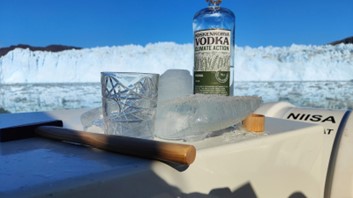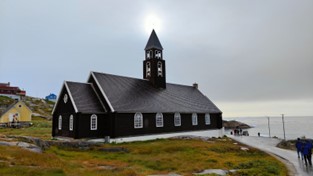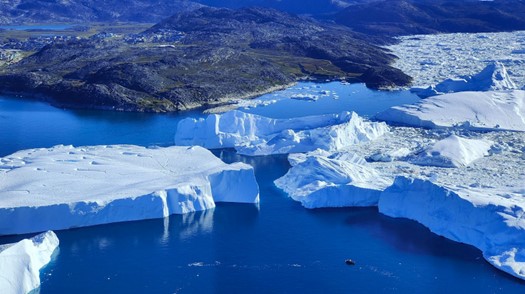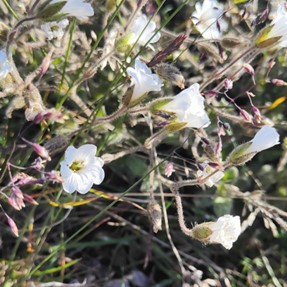I spent 5 days in Ilulissat, Greenland to learn about climate change & sea level rise from the melting ice due to climate change.
Huge thanks to John Englander and the team and to Christine Woodhouse who sponsored RIDC Ltd. to go on this incredible journey.

My trip began with a quick stop-over in Copenhagen, Denmark, to liaise with John (Trip Organiser and Founder of The Rising Seas Institute) and the other members of the team (See image above). We spent some time as group bonding before the journey ahead whilst we were also joined by Liam (William) Colgan, a senior researcher at the Geological Survey of Denmark & Greenland. Early discussions express excitement for the beauty of the ice which is slightly reserved as we are all aware of the depressing fact that, what we are about to experience, is also akin to checking up on a terminally ill patient. The patient is deteriorating and we will be seeing the current status upon each sight of the Greenland Ice sheet.
The first morning begins with a briefing on the upcoming itinerary during our stay in Ilulissat, Greenland. Immediately we are heading to the airport to catch our flights to Kangerlussuaq and then on to Ilulissat. A brief stop in Kangerlussuaq allows us just enough time to leave the airport to view a bridge which was the site for a famous glacier flood that destroyed the bridge in 2012. An early reminder that we will be seeing, 1st-hand, the effects of climate change on glacier melt.
Our next stop brought us to our intended destination, Ilulissat. Before even landing we are met with small icebergs from the window of our plane, which steadily grow in number. As we get closer we begin to see an abundance of larger icebergs, apparently frozen in place, but slowly moving south as they break off from their parent glacier. Ilulissat has a small bay that allows boats access to the harbour but is greeted by an ice fjord that regularly spits out icebergs with huge variations in size.

Once settled in the hotel we venture back out to receive our first guided tour of the expedition by a young Danish woman. A huddled tour is proceeding with ‘unusual weather’ in the form of light rain gently falling from the sky, in and out of a small craft workshop where local people carve Tupilaq (Made from reindeer), along the busy harbour where they land fresh halibut and other vessels taxi through, to the oldest church in Greenland with a spectacular view of icebergs in the bay (below). A slight mishap from the guide on her interpretation of where the loud cracking noises come from saw us become the ‘bubbles brigade’ from here on out and a memorable moment for myself and the team.
Our second adventure of the day began after dinner in our hotel when myself, Damon Winters and Steve Hall set out on a short hike to point on the peninsula (Seen above in Figure 3) where we could get a good view of the icebergs leaving the fjord under the light from the setting sun (which doesn’t ever fully set). We were accompanied by a greenlandic dog (See below), that had shown up unannounced, initially following us but graduating to ‘guide’ our way to the top when the path got a little tougher up to the peak. We were greeted at the top by the stunning sight of a small pod of whales that were coming into the bay to the mouth of the fjord to feed most likely. A beautiful moment of incredible views and entertaining behaviour from the whales, characteristically breaching and proudly raising their tails out of the water.

Our moment of bliss was crudely dismissed by the roar of three boats also heading towards the mouth of the ice fjord. We quickly realised the reality of the situation when their position began to strategically corral the whales long enough for a loud bang from a gun to echo through the bay and give us a jolt back to the reality of the way of life in Greenland. A moment that still sticks out in my mind from my trip here, an exciting moment crushed under the weight of the reality here. Although, after some time had passed, the group of whales resurfaced split into two smaller groups far into the distance away from the boats and we watched the seemingly disappointed hunters return slowly to the harbour before returning down from the peak recounting the experience as we hiked. Our first day ended with excitement and drama filling our ‘bellies’ with plenty of anticipation for the subsequent days adventures to come.
Our second day began with another trip to the harbour but this time was to venture out on a boat to view a calving event at the Eqi glacier and also conduct a ‘scientific’ test with some of the ice gathered from the foot of the glacier. The Eqi glacier is one of Greenland’s largest glaciers and is located on the west coast of Greenland constantly leaking massive icebergs into the surrounding area of Disko bay. It is quite an active glacier with minor calving events taking place her dozens of times throughout the day.

Figure: The Eqi glacier located 2 hours North of Ilulissat by boat. The walls of the glacier seen here were between 270-300 metres tall.
We used some appropriately named Climate Action (Not sponsored) vodka, to ‘test’ our ice samples to see if ice from glaciers contained pressurised air samples from the atmosphere that was captured within the ice. We learned that when liquid was added to the glass the ice began to melt and a hissing or popping sound could be heard from the glass. The liquid was adequately disposed of in a safe and controlled manner…
Figure: Photo of pressurised air sample test in front of the Eqi glacier
Whilst stopped near the glacier for 2 hours we witnessed nearly 20 small calving events and this served as a powerful background ambience to another discussion with the team about what we were experiencing next to the glacier and why. John pointed to the left side of the mouth of the glacier and explained how the difference in colour of the rock told us the rate of the melt over years past (See below). A frightening visual reminder of the rate of ice melt due to climate change.
Our second last full day brought us back to the airport to take a plane journey north to the Eqi/Jakobshavn glacier, a stunning view ‘over the wall’ of ice on to the white, seemingly endless, glacial horizon.
We flew over the glacier and inwards over the ice sheet to circle swiss camp, a weather station that was recently decommissioned due to danger the ice melt was creating for the camp. Two visual climate change reminders stand out to me about the plane trip over the greenland ice sheet. One, the remains of the dismantled swiss camp and again, a visual marker of where the glacier had been at one point in the last 50 years.
A trip to the Ice Fjord visitor centre in Ilulissat which sits at the top of a hill overlooking the town at its edges, home to the majority of the towns working Greenlandic dogs and a part of the UNESCO world heritage area. The visitor centre provides some intriguing exhibits, notably ice core samples taken from the Greenland Ice sheet preserved in glass with easy viewing of the pressurised air samples encased in the bubbles within the ice.

Figure : View of the walk down Sermermiut Valley from the top of the Ice Fjord Visitor Centre in Ilulissat, Greenland.
After the visitor centre we did the short hike down Sermermiut Valley to what is known locally as Widows Leap. Sermermiut is a site that was home to various cultures: Saqqaq, Dorset and Thule. This once inhabited site which has managed to preserve a significant portion of the signs of settlement, now hosts a boardwalk down the valley and to the edge of the Ice fjord (See below) to preserve the ecology found within the valley. The valley is home to ancient artefacts from past settlements with many tools being preserved in the peat frozen as permafrost. With the gradual melting of permafrost more of the remains of this settlement have come to light but caution must now be taken to preserve the site to avoid any further damage that was being caused by hiking trails through the valley. We passed a couple of local people who had just come back from the valley collecting mushrooms (birch bolete and puffballs) which can be found whilst walking along the boardwalk amongst the countless other species of wetland plants that can be found here (see above, flower image below).

Figure : Calving front of the Jakobshavn glacier with dated demarcations. Taken from: https://svs.gsfc.nasa.gov/3806. Updated for the years 2013 and 2014 by E. Olsen.
Our last excursion for the trip took us to the village of Ilmanaq, a small village home to the 2-star michelin restaurant Koks who have called a little lodge their home for the past year whilst they await the completion of their new home in the Faroe Islands. The selection of local fresh food was extraordinary alongside the presentation and the sights of Whales as we were eating made for a truly unique dining experience.

Figure : Seaside view from Koks restaurant in Ilimanaq
Our last day in Greenland gave us enough time in the morning to have a little debrief. It was hard to believe the time had gone so quickly and that we were preparing to leave again. During the debrief we allowed ourselves time to reflect on what we had seen over the course of the trip.

Konrad Steffen lost his life in 2021 to what is believed to be a crevice in the ice that was covered by snow just metres from swiss camp whilst on a research expedition with his son and 3 other colleagues. A close friend to John, we took a moment to watch the Thwaites Glacier collapse in 2012 and John shared a heartfelt anecdote about a great scientist and friend ‘Koni’ as he was well known to others. Koni was an inspiring scientist that has spent over 40 years of his life researching climate change in the polar and high mountain regions. It was an emotional moment for all to hear of a man who had dedicated his life to the ice to leave us so soon.
Increasing melt has also given us unfortunate events in the form of the Italian Alpine Glacier collapse and the Helheim Glacier Collapse, both occurring within weeks of each other in July 2022. This more recent example of a mega calving event that has taken place in Greenland shows the viewer the scale of the collapse and also indicates the increase in melt due to climate change.
We remember those that have sadly lost their lives as a result of the changing climate on earth.
Conclusion
My time there could be summed up in three words (well, 2 words and a phrase) : powerful, emotional and beautifully sad. It was powerful in the lessons taught by John and the landscape itself, an emotional rollercoaster with amazing highs and lows as we experienced a variety of events unique to Greenland and beautifully sad because every view was breathtaking and sad because it was slowly diminishing before our very eyes albeit fractionally insignificant whilst considering the bigger picture. The visual indicators I have mentioned throughout this blog acted as a constant reminder to the long-term damage humanity is invoking on the planet.
I am writing this blog post-hoc from the comfort of my home in Bangor, Wales and I find myself missing the brisk wind at sea and cramped flights but I will take what I have learned from my Greenland experience and hope that I will get to return one day.
Real Ice cannot possibly hope to mitigate Rising Sea Levels unless a large-scale solution can be developed for re-icing on land. Although, we do aim to help by producing a renewable powered pump that will flood/spray seawater from below the ice onto the sea ice surface encouraging the natural icing process during the winter to last through the summer. We can do this via localised re-icing of key areas. We would be targeting sea ice in the Arctic to increase the thickness and, as a result, create multiyear ice that will last through the summer months and the melting period till the following winter. It is essential that we approach this collaboratively with all stakeholders in the Arctic. We hope that we can inspire others to generate solutions to greenhouse gas removal, removal of fossil fuels and ecosystem restoration.
Is humanity really capable of working together quickly enough to protect its people whilst facing this inevitable catastrophe of Sea Level Rise?
I believe so and I am hopeful it will be before it's too late…
Acknowledgements
To John Englander and the Rising Seas Institute for organising and facilitating throughout the trip.
To Christine Woodhouse for sponsoring Real Ice to make this journey possible
To the other members of the team: Damon, Sweta, Jose, Arlene, Linda, Ralph and Steve it was a pleasure to meet you all and spend the time getting to know each of you.

















Commentaires